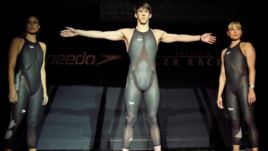VOA常速英语:High-Tech Edge Sharpens Olympic Games
At the very first Olympic Games, in 1896, an American won a gold medal in the pole vault event he jumped 3.30 meters using a wooden pole.
Four years ago in Beijing, an Australian won gold in the same event with a 5.96-meter jump. The pole he used was lighter and stronger and made from carbon fibers.
When the 2012 Olympic games begin later this month in London, athletes will not only be better-trained than ever before, but also better-equipped.
“What we have seen really is nothing short of a revolution, particularly in the use of advanced materials, integrated with engineering design,” says Michael Caine, a professor of sports technology at Loughborough University in England.
Breaking records
He says athletes with lighter and stronger bats, rackets and golf clubs can hit balls further, harder or with more spin. Often these engineering innovations can be tracked by the records in the sport.
Until the Beijing Games in 2008, there was an average of 22 record-breaking performances during each Olympiad. At the Beijing Games, 108 new records were set. Caine says in swimming, 94 percent of the races were won by athletes wearing full-body swimsuits made with engineered materials.
|
|
| American Olympic medalists Amanda Beard, left, Natalie Coughlin, right, and Michael Phelps pose in the high-tech Speedo LZR Racer swimsuits worn at the 2008 Beijing Summer Olympics. |
“Which was making the athletes’ hydrodynamics much superior [than] with previous suits," Caine says. "And you could see that in the times that were set and the number of world records that were falling.”
This ignited a debate over what Caine calls "technological doping," that materials - like those in the swimsuit - give the 'haves' an unfair advantage over the 'have-nots.' The governing body for swimming later banned the special suits from competition.
“Of course if you have technology dominating, or if you have a technology that’s limited to richer nations, then the ethos of fair competition comes into question,” Caine says.
Boosting performance
While the full body swimsuits made a big splash in Beijing, new equipment won’t be as visible in London. Most of the technological innovations boosting athletic performance are more evident during the training process.
“For monitoring and feedback between the coach and the athletes," Caine says. "We’ve seen a huge amount of advance in miniaturization of sensors, in wireless technologies, in the way athletes communicate with their performance teams, in the way we monitor an athlete’s recovery from a training program, in the way we look at their nutritional status and make changes to what they are eating and drinking and so on.”
The materials engineered for elite athletes, like the strong, flexible carbon fiber used in clubs, rackets and bikes, have also found a solid foothold in the market place. They are common components in cars and airplanes and have been incorporated into the design of modern wheelchairs.
Motion tracking is another sports-training innovation.
“It was developed for monitoring the swing profile of tennis players and golfers," Caine says. "It is now being used for stroke rehabilitation, where you can look at the gait patterns of the patient and how closely they are to a normal gait pattern.”
Despite the boost these innovations can give an athlete’s performance, Caine says what he hopes to see in London is that the best, most dedicated athletes win. Writing in Nature Materials, he adds, “The need to balance innovation and tradition in sport is set to remain an enduring and compelling challenge.”
- 频道推荐
- |
- 全站推荐
- 推荐下载
- 网站推荐





















